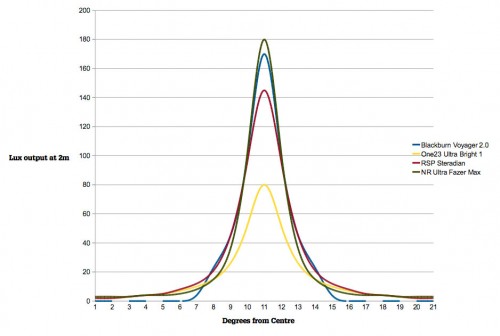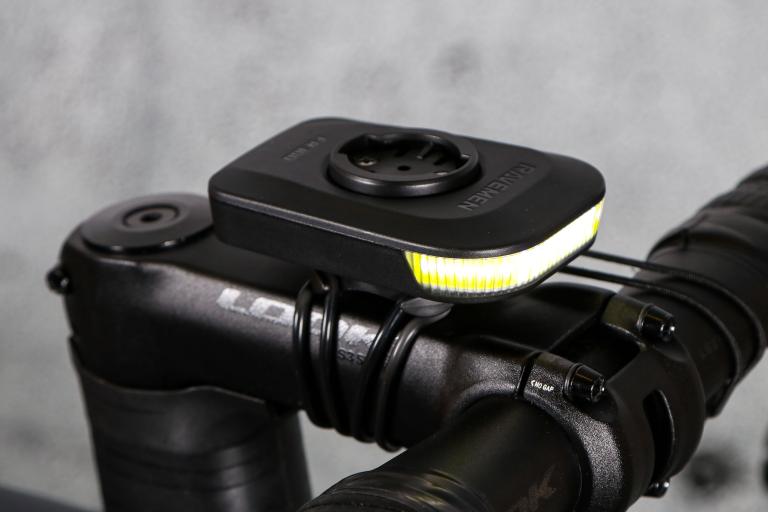- News
- Reviews
- Bikes
- Accessories
- Accessories - misc
- Computer mounts
- Bags
- Bar ends
- Bike bags & cases
- Bottle cages
- Bottles
- Cameras
- Car racks
- Child seats
- Computers
- Glasses
- GPS units
- Helmets
- Lights - front
- Lights - rear
- Lights - sets
- Locks
- Mirrors
- Mudguards
- Racks
- Pumps & CO2 inflators
- Puncture kits
- Reflectives
- Smart watches
- Stands and racks
- Trailers
- Clothing
- Components
- Bar tape & grips
- Bottom brackets
- Brake & gear cables
- Brake & STI levers
- Brake pads & spares
- Brakes
- Cassettes & freewheels
- Chains
- Chainsets & chainrings
- Derailleurs - front
- Derailleurs - rear
- Forks
- Gear levers & shifters
- Groupsets
- Handlebars & extensions
- Headsets
- Hubs
- Inner tubes
- Pedals
- Quick releases & skewers
- Saddles
- Seatposts
- Stems
- Wheels
- Tyres
- Health, fitness and nutrition
- Tools and workshop
- Miscellaneous
- Buyers Guides
- Features
- Forum
- Recommends
- Podcast
review
£29.99
VERDICT:
Impressive budget light for sub/urban commuting and winter training
Weight:
131g
Contact:
www.cyclelife.com
At road.cc every product is thoroughly tested for as long as it takes to get a proper insight into how well it works. Our reviewers are experienced cyclists that we trust to be objective. While we strive to ensure that opinions expressed are backed up by facts, reviews are by their nature an informed opinion, not a definitive verdict. We don't intentionally try to break anything (except locks) but we do try to look for weak points in any design. The overall score is not just an average of the other scores: it reflects both a product's function and value – with value determined by how a product compares with items of similar spec, quality, and price.
What the road.cc scores meanGood scores are more common than bad, because fortunately good products are more common than bad.
- Exceptional
- Excellent
- Very Good
- Good
- Quite good
- Average
- Not so good
- Poor
- Bad
- Appalling
The RSP Steradian gets its name from the Greek for ‘solid beam’. It uses a single-watt LED that seems a lot brighter thanks to clever collimator lens technology, which is traditionally used to guide lasers. You get a very crisp, solid beam that’s good enough in high power mode for shorter journeys in pitch darkness.
Raleigh say the Steradian pumps out an impressive 1200 candlepower, three times that of some other single watt lights. There are three lighting modes: high, low, and flashing. The highest setting provides a spotlight with pin-sharp focus, giving sufficient light to see properly on unlit, rural lanes at 16mph. An integrated cowling prevents the light from shining upwards and dazzling.
It’ll last 19 hours on high power, compared to 26 in low and 33 in flashing, and you can eke out the run time by switching between modes as necessary. Flashing is particularly effective for being seen by in twilight conditions and when tackling urban traffic systems with roundabouts and side roads. Last season’s RSP range suffered from poor peripheral visibility. This has been greatly improved for 2010/11; from the graph you can see that although it's not as bright in the centre as some competing lights, it has a good peripheral spread.

The weather sealing and build quality are as good as lights costing twice as much, and the Steradian’s dense plastic casing should take road vibration and casual commuter carelessness in its stride. The sensible positioning of the switch should prevent the light flicking on at the bottom of a bag. It’s easy to turn it on or off or toggle between modes while riding, however, and the switch has a positive feel when pressed.
Popping open the casing reveals the sealed lens and the battery tray for its four AAAs. This sealing is effective, giving the Steradian impressive weather resistance. Mine has shrugged off prolonged downpours. Even a five-minute onslaught from the garden hose couldn’t reveal any weaknesses. The tool-free bracket fits securely on most handlebar diameters, and stays firm even on rougher roads, bridleways and towpaths.
The Steradian could be all the light you need for commuting and suburban winter training, particular if you’re only making shorter journeys. The latest generation of rechargeable systems still have the edge in convenience and long-term economy.
Verdict
Impressive budget light for sub/urban commuting and winter training
road.cc test report
Make and model: RSP Steradian LED front light
Size tested: n/a
Tell us what the product is for, and who it's aimed at. What do the manufacturers say about it? How does that compare to your own feelings about it?
'RSP Steradian 1 watt front light. Integrated collimator lens technology for optimum efficiency and output.' Essentially it's a very competent commuter light.
Tell us some more about the technical aspects of the product?
Latest collimator technology provides superior optical efficiency, increasing lumen output.
output and better light distribution. This results in a 1 watt LED generating 1200
candle power output.
Rate the product for quality of construction:
7/10
Better than some costing nearly twice the price.
Rate the product for performance:
8/10
Rate the product for durability:
7/10
Very well sealed from the elements.
Rate the product for weight, if applicable:
7/10
Rate the product for comfort, if applicable:
7/10
Rate the product for value:
8/10
Very good, given the level of performance.
Tell us how the product performed overall when used for its designed purpose
The Steradian is a remarkably capable lamp that offers excellent illumination in most contexts. Weather seals are better than I had any right to expect and should resist pretty much anything the elements dish out. Perfect for round town and the suburbs, there's sufficient to see by along the lanes in the highest setting but budget high power rechargeable NiCad/NiMh types have the edge for regular rural duties.
Tell us what you particularly liked about the product
Excellent output, reasonable run times, sensible, solid build quality.
Tell us what you particularly disliked about the product
Nothing of note.
Did you enjoy using the product? Yes
Would you consider buying the product? Possibly
Would you recommend the product to a friend? Generally, yes.
About the tester
Age: 37 Height: 1m 81 Weight: 70 kilos
I usually ride: Rough Stuff Tourer Based around 4130 Univega mtb Frameset My best bike is: 1955 Holdsworth Road Path and several others including cross & traditional road
I've been riding for: Over 20 years I ride: Most days I would class myself as: Experienced
I regularly do the following types of riding: cyclo cross, commuting, touring, fixed/singlespeed, mtb,
Shaun Audane is a freelance writer/product tester with over twenty-eight years riding experience, the last twelve (120,000 miles) spent putting bikes and kit through their paces for a variety of publications. Previous generations of his family worked at manufacturing's sharp end, thus Shaun can weld, has a sound understanding of frame building practice and a preference for steel or titanium framesets.
Citing Richard Ballantine and an Au pair as his earliest cycling influences, he is presently writing a cycling book with particular focus upon women, families and disabled audiences (Having been a registered care manager and coached children at Herne Hill Velodrome in earlier careers)
Latest Comments
- 3BO 5 min 24 sec ago
3BO has cracked it, shipping a product that is integrated with Whatsapp. Convenient and clever.
- Simon E 8 min 36 sec ago
Everything in moderation, my dear fellow....
- bensynnock 10 min 42 sec ago
Even a slow cyclist can seem fast to somebody who is standing still and not expecting to see a bike.
- JMcL_Ireland 1 hour 46 min ago
I absolutely stand by my criticism of Elite (note: I'm not criticising the volunteer marshals). They charge an arm and a leg for these events but...
- Destroyer666 1 hour 59 min ago
There's a lot of good stuff here, but shoe reviews are still lagging on average when comparing to for example bike or tire reviews. Specs relating...
- galibiervelo 2 hours 32 min ago
Loved the Bastion in the flesh but Lemond's bike has the soul. Nice event and met some friends and contacts but like the magazine, it does promote...
- chrisonabike 3 hours 24 min ago
Awaiting the next feckless driver asking the judge to delay the start of the sentence because "they owe a few more cyclists a proper goodbye"....
- Hirsute 4 hours 42 min ago
All in the article - road tax.
- chrisonabike 5 hours 56 min ago
Ah, but: in UK, if a motorist drives into you (or simply parks in a cycle lane, forcing you out into the path of another motorist) then the council...










Add new comment
5 comments
Excel is a bit crap for graphs.
You could convert your Y-axis to candela (then you wouldn't need to specify the measuring distance). At 1 metre distance 1 lux = 1 candela. At 2 metres 1 lux is 4 candela, so all you need to do is multiply the values by 4.
The peak intensity of the RSP Steradian light looks like it is about 145 lux at 2 m, which is 580 candela. Since one candlepower is roughly one (actually 0.981) candela, it is hard to see how Raleigh claim 1200 candlepower.
yeah, it should. excel not my strong point, back to the PHP
I've added the beam test graph to the review; sorry, should have been there from the start
Since that's a quantitative measure of the light's total output, it's also meaningless without knowing the beam pattern, for exactly the same reason. We measure lux at 2m over a 60° arc as we think that's more helpful and comparable.
Yes, your measuring of the beam pattern is even better.
But without knowing the pattern of the beam, knowing the total output of the light (lumens) is more useful than knowing candlepower. A light with twice the total light output will be better than another light at illuminating your environment, if you assume that the beam pattern is the same. ie: The consumer knows that any differences between two lights with the same rating in lumens will be down to the design of the reflector and lens. (Assuming that the lumens ratings are accurate.)
Your graph is a great way to compare lights. But I think your X-axis, which goes from 1 to 21, is wrong. Shouldn't it go from -30º trough zero to +30º?
Comparing candlepower is meaningless without knowing the angle the cone of the beam (ie: perfect for marketing cheaper lights). eg: A laser pointer might have a 500,000 candlepower beam, but since the beam is columnar and only 1 mm in diameter, it wouldn't be much use to light your way home.
All Raleigh are saying here is that the spot from their beam is one third the area of other one watt LED lights, thanks to its collimator lens. They don't have a better LED.
To compare lights you need lumens.